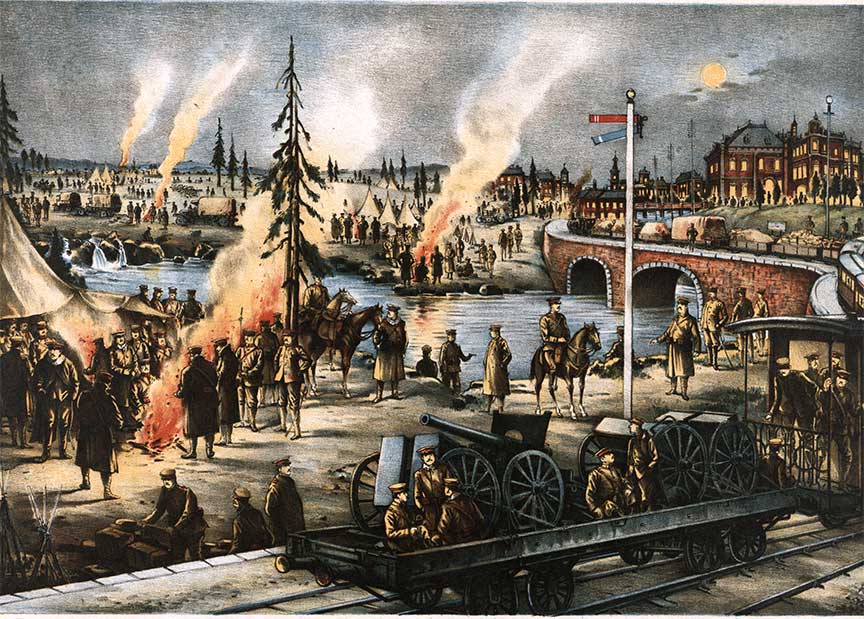1919 White Russians Defeated

Allies in Siberia
The communist government faced civil war in opposition to its rule. The Reds faced what was called the White Army. The While army had three armies each attempting to advance on Petrograd and Moscow. The White armies initially made rapid progress, however, the Red army under Trotsky soon turned into a well trained army and succeeded in leading it to victory. French, English, Japanese and US troops had landed in Siberia ostensably to stop Russian supplies falling into German hands. The Allies helped the White Russians, but as they collapsed the allies pulled out.
The Bolsheviks had come to power by effectively staging a coup against the interim government. They faced multiples levels of opposition. Leading the charge to remove the new rulers from power were some of the former Tzar's generals. They led what became known as the White Army. The Allied Armies, who had fought Germany, supported the White Army to a greater or lesser degree. The fear of the Bolsheviks was genuine, but there was a concern that Allied intervention might have the opposite of the desired effect. British Prime Minister Loyd George told the British War Cabinet on December 31, 1918, "but the attempt to emancipate her(Russia) by foreign armies might prove a disaster to Europe as well as Russia. The one thing to spread Bolshevism was to suppress it. To send our soldiers to shoot down Bolsheviks would be to create Bolsheviks here. The best thing was to let Bolshevism fall by itself and act at a deterrent to the world."
Despite their concern, all of the allies gave support in various degrees to the anti-bolshevik forces. By the middle of February, the forces arrayed against the government had nearly half a million men under arms, and they were advancing steadily. The Allies, however, began to have cold feet and slowly withdrew support from the anti-Bolshevik forces. This occurred as the anti-Bolshevik forces seemed divided on their goals. The White Army also suffered from frequent mutinies, with some of their troops suddenly changing sides. Some of the White Army was also responsible for killing many Jews in the areas they captured. Some estimates state that the White Army killed 100,000 Jews. These killing further eroded support for the White Army. The British had been maintaining a naval blockade of Russia, but that was soon ended. A British officer who was sent to oversee British troops' evacuation wrote about the White Russians "Their troops won't fight alone, and their officers are hopeless. The trouble with the White Russians is that they have no real leaders of character and determination. The Bolshevikds on the Bolsheviksknow what they want and are working to get it."
Despite losing most of their Allied support, the White Armies fought on. By early October 1919, they controlled all the major cities of Russia except for Moscow and Petrograd. The White Russian troops advanced to within 40 miles of Petrograd. Overall the Whites had 650,000 men facing a Bolshevik army of 450,000.
On October 21, October 21, the White Army led by General Nikolai Nikolayevich Yudenich was poised to assault Petrograd. It had nearly cut the rail line between Moscow and Petrograd, and victory seemed within its grasp. However, the next day, the anarchists working with the Bolsheviks seized two crucial rail junctions that provided the Yedenich army with supplies. Taking advantage of the moment, Bolshevik forces in Petrograd led by Trotsky launched a successful counteroffensive. The Bolsheviks convinced several Tsarist Generals to join and fight the White Army Yudenvich's army was now in full retreat to build on the momentum. In the meantime, Lenin reached diplomatic agreements with Poland and Estonia, guaranteeing their independence; thus, neither provided any additional help to the White Army and interned their members. At this point, the Allies withdrew any support they were still giving the Whites, and the fighting ended in Western Russia. The final vestiges of the White Russian Army were defeated in Siberia in 1923.
 >
>